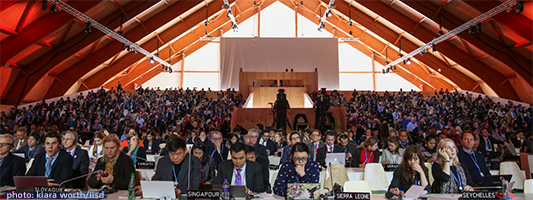This April saw the launch of the one-year period for national governments to ratify the Paris Agreement on climate change reached at the COP 21 in Paris, the final stage before entry into force.
The international community greeted with enthusiasm the substantial Paris Agreement on climate change produced last December by the UNFCCC 21st meeting of the Conference of the Parties (COP 21). Since it first came out, this Agreement has been analysed in many circles, including by us in EuropeInfos. We also agree that it achieved the fundamental goals of the negotiation: recognition that 2 ºC should be set as the upper limit of average global temperature increase, commitment to providing the necessary finance, and recognition of the common yet differentiated responsibilities as a guiding principle.
The Agreement has also found pragmatic solutions for addressing the most controversial issues. For example, setting voluntary national objectives that allow national sovereignty to be preserved, and establishing periodical reviews that will in the future enable the common responsibilities to be distributed more efficiently.
Time for ratifications
After approval of the Agreement in Paris, now comes the official stage for governments to embark upon their national procedures for depositing their “instruments of ratification, acceptance, approval or accession”. This period was launched on 22 April at a high-level ceremony at the UN headquarters in New York and it will run until April 2017. The minimum number of ratifications for the Agreement to enter at once into force is 55 of the 195 countries that are not only signatories to the UN Convention but also together accounting for not less than 55% of total global emissions. The chances of the Agreement being ratified are high, because countries like China, US, India, Russia, Japan and the European Union, who together account for over 70% of the total emissions, have already expressed their willingness to do so.
At the moment of ratification , each state is also required to submit its first nationally determined contribution (NDC). These “contributions” are the greenhouse gas emissions reduction targets that the countries intend to achieve. At the time of writing this, only 17 countries have submitted their official ratification instruments, but the international community is confident that the quorum of 55 will be achieved. There are even a number of commentators predicting that the Agreement could be fully operational by 2018, without waiting until 2020.
In brief, ratification of the Agreement also triggers the time for implementation by the nation states. Decisions have to be taken to “decarbonise” the economy. This will inevitably speed up the transition towards renewable sources of energy. After the ratification of the Agreement the states have to demonstrate not only willingness but also concrete actions leading towards the achievement of the declared national contributions.
Underestimated costs
There is also a high degree of confidence that the financial commitments –estimated as totalling 100 billion dollars per year up to 2050 – will be covered. Reports disclosed by the OCDE during the COP 21 showed that more than 60% of this figure has already been invested by the international community. Nevertheless, a recent report by the United Nations Environment Programme has warned that adaptation costs have so far been underestimated. In fact, the report shows that at least four or five times that amount will be needed to meet the challenges that climate change will bring by 2050.
Although these are estimated figures only, and therefore subject to further research and confirmation, it is interesting to observe that there are more calls nowadays for greater attention to be paid to adaptation than was the case during previous negotiations. When talking about the most vulnerable people affected by climate change, it is clear that adaptation has become crucial.
In our view, the process of the Paris Agreement is moving in the right direction. Although the risks are not removed, we must recognise that today at least we now have a consistent legal framework that can foster optimism, or at least open up hopes that the spirit of responsibility will be the guiding principle in international dealings in this field.
The influence of Laudato si’
We are now celebrating the first anniversary of Pope Francis’s Encyclical Laudato sí. This Encyclical certainly exercised a highly very positive influence on the road to Paris. The voice of the Pope, and through him that of the Church, provided robust moral support for an ambitious and binding agreement to be reached. Of course, the future challenge facing civil society is huge. However, the Encyclical shows that there is also a long road ahead for the Church herself when coming to grips with environmental issues.
After the massive response to the appearance of the Encyclical, the attention has been given to understand its content. But now, we should move to get environmental issues accepted as part and parcel of both our thinking and the way we live our lives, will this then be seen as the greatest contribution of the Church to this process.
Jose Ignacio Garcia SJ
JESC


